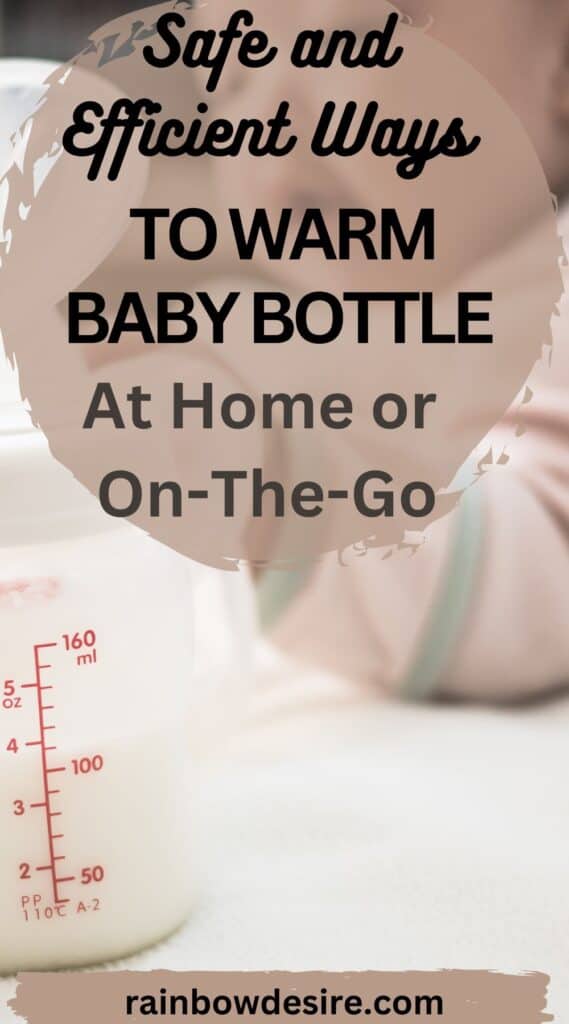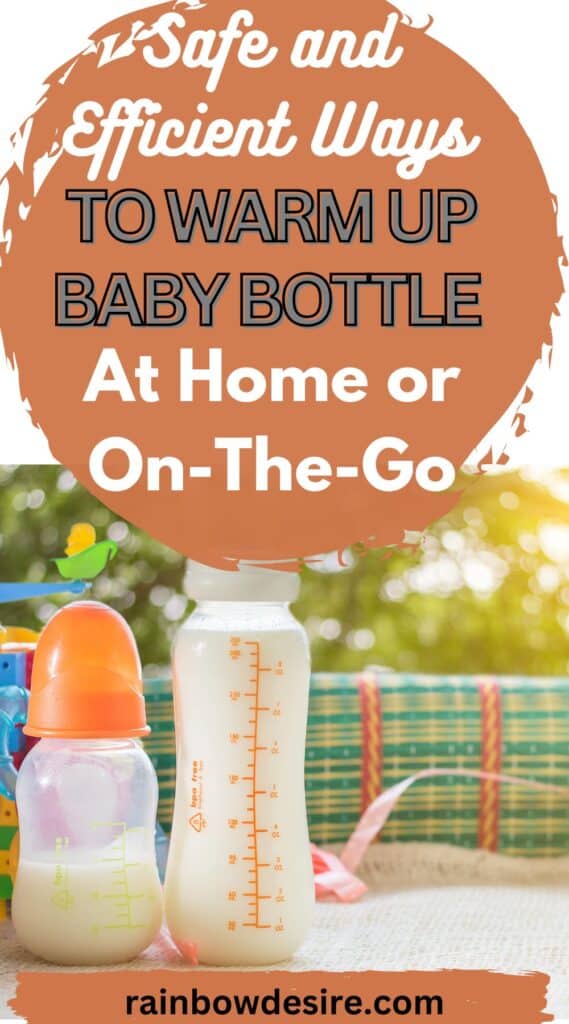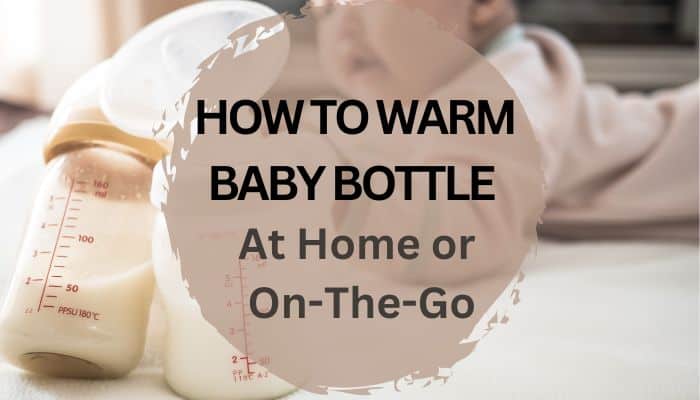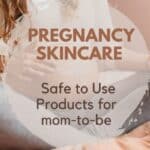Warming baby bottles is an important aspect of caring for your little one, especially when it comes to serving breast milk or formula at the right temperature. Finding the perfect method to warm up your baby’s bottle can be challenging, but don’t worry, we have you covered. In this article, we will discuss safe and efficient ways to warm baby bottles that will make feeding time more convenient and enjoyable for both you and your baby.
The temperature of the liquid you serve to your baby matters because it can affect their digestion and overall comfort during feeding. Using unsafe methods, like microwaving, can cause uneven heating and potentially burn your baby’s mouth. Therefore, learning the most effective and safe techniques for warming bottles is essential. From bottle warmers to countertop methods, we’ll explore various options that will ensure your baby’s milk is at the ideal temperature every time.
This post may contain affiliate links. Please read our disclaimer for more information.
Understanding Baby Bottle Basics
Types of Baby Bottles
There are three main materials to choose bottles: glass, plastic, and silicone. Each material has its advantages and disadvantages that will impact your decision.
- Glass: Glass bottles are durable, easy to clean, and do not contain harmful chemicals. However, they are heavier and can break if dropped.
- Plastic: Plastic bottles are lightweight, affordable, and widely available. On the downside, they can wear down over time and may contain chemicals like BPA if not specifically labeled as BPA-free.
- Silicone: Silicone bottles are flexible, lightweight, and free of harmful chemicals. They offer a more natural feel for your baby, but they can be more expensive than other options.
Importance of Warming Baby Bottles
Warming your baby’s bottle is essential for a few reasons:
- Comfort and preference: Babies, especially newborns, prefer milk at a temperature close to body temperature. Warming bottles can make feeding more enjoyable for your baby.
- Preserving nutrients: It’s important to maintain the nutritional value of breastmilk or formula by using a gentle heating method. Avoiding overheating ensures that your baby receives the maximum benefits from their feeding.
- Safety: Warming bottles evenly helps prevent any hot spots, which can cause burns to your baby’s mouth or throat.
To effectively warm your baby bottles, you could use methods such as placing the bottle in warm water or using a bottle warmer. Take precaution not to overheat your baby’s bottle, always testing the milk’s temperature before feeding. Remember to swirl the bottle occasionally to distribute the heat evenly and avoid shaking the bottle vigorously, which can introduce air bubbles.
Methods of Warming Baby Bottles at home and on-the-go
Bottle Warmer
Using a bottle warmer is a quick and safe way to heat your baby’s bottle. Most bottle warmers use steam to raise the temperature of the milk, making them an ideal solution for late-night feeding sessions. Simply place the bottle in the warmer, set the desired temperature, and it’ll be ready for feeding in a few minutes.
Microwave
Although using a microwave is not recommended due to the risk of uneven heating and hot spots that can burn your baby’s mouth, some parents might still choose this method. If you do use a microwave, ensure that you shake the bottle well after heating and test the temperature of the milk on your wrist before feeding.
Use Electric Kettle
The most efficient way to prepare warm baby formula bottle is by using an electric kettle. Warm milk as per you desire or add room temperature water to make it perfect for baby.
You can also warm your baby’s bottle using hot water. Place the bottle in a bowl of hot water or hold it under warm-to-hot running water, rotating it around to reach all sides for roughly two minutes. This method is easy and costs nothing, but it can take several minutes to warm the bottle to the desired temperature.
You can also use this hot water to thaw frozen milk or warm breastmilk in a container. Not only for babies, this kettle is a great way to make lactation milk tea for nursing moms.
Stove-Top
Another way to warm your baby’s bottle is by using a pot of warm water on the stove-top. Place the bottle in the pot, ensuring that the water level covers most of the bottle but doesn’t reach the lid. Heat the water on low heat, swirling the bottle occasionally until it reaches the desired temperature.
Portable Bottle Warmer for on-the-go
A portable bottle warmer can be quite helpful for parents on the go. These devices usually have a compartment for the bottle and use battery power or a car adapter to warm the milk evenly. These warmers often take longer than other methods but are perfect for long car rides or outings.
Thermos for using warm water to prepare the formula
A thermos can be used to store hot water, which can then be poured into a cup or bowl to create a warm water bath for your baby’s bottle. Simply place the bottle in the warm water bath and allow it to sit for a few minutes until it reaches the desired temperature. This method is convenient for parents who don’t have access to electricity or a stove-top.
Remember to always test the temperature of the milk on your wrist before feeding your baby to ensure it’s warm, but not too hot.
What is the Correct Temperatures for Warming Baby Bottles
To provide the best experience for your baby, knowing the correct temperatures for warming baby bottles is a must. This section will explore the ideal temperature for breast milk and formula.
Ideal Temperature for Breast Milk
When warming breast milk, aim to reach a temperature that is at or near body temperature (around 98.6 degrees Fahrenheit). Breast milk naturally reaches this temperature when a baby nurses directly from the mother. Maintaining a temperature close to body temperature will help preserve the nutritional content and avoid scalding your baby’s mouth. Remember, when warming the milk always to test the temperature on your wrist and ensure there are no hot spots before feeding your baby.
- Never overheat breast milk, as it can destroy essential nutrients.
- Gently swirl the bottle to distribute the heat and eliminate any hot spots evenly.
Ideal Temperature for Formula
The ideal temperature for warming formula is also close to, or just below, body temperature (98.6 degrees Fahrenheit). Room temperature is usually sufficient for preparing powdered formula, but when warming a previously refrigerated bottle, aim to reach a temperature closer to body temperature for your baby’s comfort. Keep these pointers in mind:
- Test the temperature on your wrist and check for any hot spots.
- Swirl the bottle gently to mix the formula and distribute the heat evenly.
In summary, follow these guidelines for the perfect temperature when warming baby bottles. Keep breast milk and formula close to body temperature (around 98.6 degrees Fahrenheit), and always check for hot spots that could harm your baby.
Understanding and adhering to these temperature recommendations will ensure a safe, comfortable, and enjoyable feeding experience for your little one.
Tips for Warming Bottles Safely
When it comes to warming your baby’s bottles, you should consider a few important things to ensure the milk is safe to consume. This section will discuss two crucial aspects to focus on when warming bottles: avoiding hot spots and preventing bacterial growth.
Avoiding Hot Spots
Hot spots are areas in the bottle where the milk is hotter than the rest, which can cause burns or discomfort for your baby. To avoid hot spots, follow these tips:
- When using a bottle warmer, follow the manufacturer’s instructions and choose the appropriate setting for the type of milk you’re warming. Most bottle warmers use steam to heat the milk evenly.
- If you opt for the warm water method, place the bottle in a jug, bowl, or pot filled with warm water for no more than 15 minutes. The water should be hot enough to heat the bottle but not so hot that you can’t put your hand in it.
- Gently swirl or shake the bottle once warmed to help distribute the heat evenly throughout the milk. Do not shake too vigorously, as this can cause air bubbles, causing gas issues for the baby.
Preventing Bacterial Growth
To minimize the risk of bacterial growth, follow these steps:
- Always wash your hands thoroughly before handling your baby’s bottles and milk.
- Use sterilized bottles, nipples, and caps for feeding. Clean and sterilize them immediately after every use.
- If you’re using stored breast milk or formula, it’s essential to heat it appropriately to eliminate any potential bacteria present. When warming frozen breast milk, the safest methods include leaving the container in the refrigerator until thawed, holding the container under warm (not hot) running water, or placing the container in a bowl of warm water until thawed.
- Once the milk is warmed, use it within a reasonable time to prevent bacteria from multiplying. Ideally, consume warmed breast milk within an hour and formula within 2 hours.
By taking these precautions, you can safely heat your baby’s bottles while avoiding common issues such as hot spots and bacterial growth. Remember to always test the temperature of the milk before feeding your baby to ensure it’s comfortable and safe.
Warming Breast Milk vs. Formula
Proper Storage and Handling
Before you start warming your baby’s breast milk or formula, storing and handling them properly is crucial.
Store breast milk in clean containers, either in the refrigerator for up to 4 days or in the freezer for up to 6 months.
On the other hand, the formula lasts up to 24 hours in the refrigerator once mixed. Always follow the specific storage guidelines provided by your baby’s formula brand.
Here is what you need to know about formula feedings.
How to warm breastmilk in a storage bag or container
There are differences in methods to consider when it comes to warming breast milk and formula. Remember that both formula or breastmilk can be fed to your baby cold or at room temperature, but some babies prefer it warm. Feeding cold milk may cause congestion in babies.
Breast milk contains valuable enzymes and nutrients, so it should be heated gently to preserve them.
- To warm breast milk by using a warm water bath method. Place the sealed breast milk container in a bowl of warm water and let it sit for a few minutes, avoiding overheating.
- Alternatively, you can hold the milk storage bag or container under warm running water, rotating it around to reach all sides until it reaches the desired temperature.
How to warm formula feeding Baby bottles
Formula, on the other hand, can be warmed more quickly. When mixing formula, you may use warm tap water instead of cold, naturally bringing it to a warmer temperature.
Also, you can warm the formula bottle using the same warm water bath method used for breast milk.
Swirl the bottles to mix the contents and distribute the heat evenly in both cases. Always check the milk temperature by placing a few drops on your wrist – it should feel warm, not hot, to avoid burning your baby’s mouth.
Note: Avoid using the microwave to heat breast milk or formula, as it can create hot spots and destroy essential nutrients in breast milk.
What feeding bottles to choose
Here is what you need to know about combination feed.











